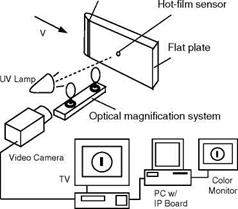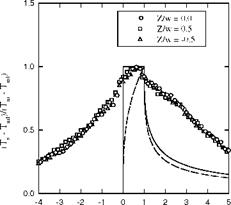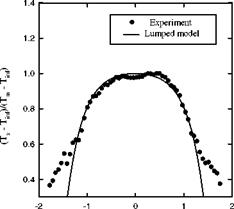. Hot-Film Surface Temperature in Shear Flow
Through an optical magnification system, a very high spatial resolution can be achieved in tSp measurements on a small object. Liu et al. (1994a) used EuTTA – dope TSP to measure a surface temperature field on a commercial flush-mounted hot-film sensor (TSI 1237) in a flat-plate turbulent boundary layer. As shown in Fig. 10.32, the sensor had a 0.127-mm streamwise length and a 1-mm spanwise length. TSP was applied to the hot-film sensor by dipping. Figure 10.33 shows the experimental set-up used for this study. The sensor was mounted flush with the surface of a flat plate with a 1:6 elliptical nose (the leading edge) that was installed in a low-speed blow-down wind tunnel at Purdue University. The sensor was located
0.37 m downstream from the leading edge of the plate. The freestream velocity was 26 m/s in the experiments. A roughness band near the plate leading edge was used to produce artificial flow transition such that the boundary layer was fully turbulent downstream. The sensor was operated at a low overheat ratio of 1.07, where the cold resistance of the sensor was 5.14 Q. The luminescent intensity images were obtained using a CCD video camera through an optical magnification system. The streamwise and spanwise surface temperature distributions were computed from the luminescent intensity images using a priori calibration relation.
Figure 10.34 shows the non-dimensional streamwise surface temperature distributions at three spanwise locations, where Z is the spanwise coordinate, L is the streamwise length, w is the half-span width, and Tm is the maximum surface temperature. Liu et al (1994a) also derived the analytical solutions for a uniform – temperature (UT) film and uniform heat source (UHS) film on an adiabatic wall in shear flow for a comparison with TSP measurements. These solutions are also plotted in Fig. 10.34 as references. The temperature distributions on the TSI hot – film sensor appeared to be nearly symmetric and largely deviated from the theoretical distributions of the UT and UHS films on an adiabatic wall. This deviation was mainly due to the dominant effect of heat conduction to the glass substrate and the streamwise diffusion effect (the finite Peclet number effect) that were neglected in the analytical solutions. This result indicated that the TSI hot – film sensor had a large heat loss to the substrate that might limit the frequency response of the sensor. The measured spanwise temperature distribution on the TSI hot film is shown in Fig. 10.35 along with a theoretical temperature distribution given by a simple lumped model for comparison. As shown in Fig. 10.35, the theoretical distribution was in good agreement with the experimental data for the sensor in a region of |z|/w <1.2. Outside of this region, the theoretical distribution underestimated the surface temperature since the lumped model neglected heat conduction into the substrate along the spanwise direction at the tips of the sensor.
|
Stainless steel tube
Fig. 10.32. Configuration of the TSI 1237 hot-film sensor |
![]()
|
|
|
|















